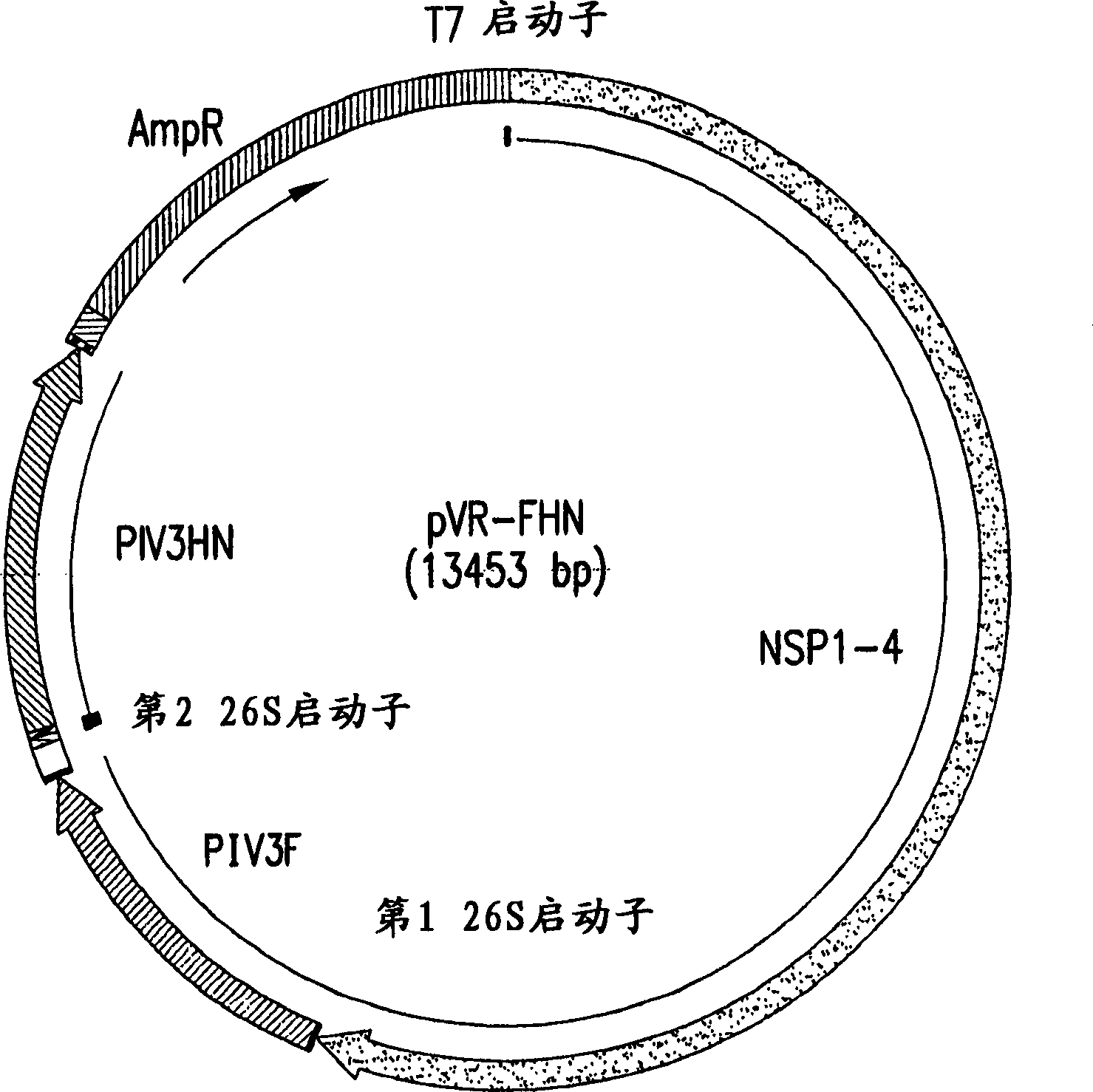Immunogenic compositions comprising venezuelan equine encephalitis virus replicon vectors and paramyxovirus protein antigens
A virus replication and immunogenicity technology, applied in the direction of viral antigen components, viruses/phages, introduction of foreign genetic material using vectors, etc., can solve the problem of the absence of preventive immunogenic compositions
- Summary
- Abstract
- Description
- Claims
- Application Information
AI Technical Summary
Problems solved by technology
Method used
Image
Examples
Embodiment 1
[0056] Embodiment 1: Construction of the VRP plasmid expressing PIV protein
[0057] The present invention uses human PIV-3 as a model parainfluenza virus. Human PIV3 virus stock (Washington 47885 / 57 strain) was prepared as previously described. See, Stokes, A. et al., Virus Research 25:91-103 (1992). Virus stocks were purified by polyethylene glycol (PEG) precipitation. RNA was extracted with Trizol-LS (Life Technologies), and reverse transcription PCR was performed using Titan One Tube RT-PCR system (Roche) as a template. Primers were used to amplify a fragment covering the entire open reading frame (ORF) of N, P, M, C, HN and F, including the 5' Kozak consensus sequence. The resulting fragment was then digested with the following restriction enzymes: Cla1 and HindIII for F, EcoR1 and BamH1 for HN, Pst1 and EcoR1 for NP, Acc1 and Xba1 for P and C, HindI11 and Xba1 for M. The resulting fragment was cloned into the shuttle plasmid pKSR1. Subsequently, the Apa1-ORF-Not1 ca...
Embodiment 2
[0059] Embodiment 2: VRP preparation
[0060] This example describes how to prepare VRP expressing each of the antigens of PIV3 by electroporating RNA from the plasmid constructed in Example 1 into BHK21 cells. The original VEE plasmid pVR100, and the two helper plasmids pHC (capsid) and pHC (gp E1 / E2) were obtained from AlphaVax (Durham, NC). See, Pushko et al. Virology 239:389-401 (1997), the entire contents of which are hereby incorporated by reference. PIV3 glycoprotein gene RT-PCR fragments were cloned individually into pVR200 or into pVR100 (HN together with F). The resulting plasmid is then transcribed in vitro to produce RNA. The RNA is then electroporated into BHK21 cells to obtain VRPs encoding NP, M, P, C, F and / or HN genes respectively (VRP-NP, -M, P, -C, -HN, -F, -F / HN).
[0061] After individual PIV genes were obtained and cloned into an appropriate expression vector, capped RNA transcripts were prepared in vitro using the Not1 linearized plasmid template and...
Embodiment 3
[0062] Example 3: Viral titers of VRP and PIV
[0063] The titer of VEE replicon (VRP) expressing PIV protein and glycoprotein was measured by immunohistochemistry. VRP was propagated in the BHK-21 cell line. In this example, BHK cells were obtained from the CCL-10 clone to distinguish it from other BHK clonal populations that do not share cryptic phenotypic features. As defined herein, the cells may be referred to as BHK21 or simply BHK cells. Infect BHK21 monolayer cells with serially diluted VEE replicons: VRPNP; VRP-P; VRP-M; VRP-C; VRP-HN; VRP-F; Cultivate for 16-20 hours. Cell monolayers were then mixed with 1:1 acetone / methanol for 5 minutes and stained with either bacterially expressed rabbit anti-VEE NSP1 protein, polyclonal antibody r835, or horse anti-PIV3 serum. Goat anti-rabbit antibody conjugated with cyTM3 (Jackson ImmunoResearch, West Grove, PA) or horseradish peroxidase (HOURP) conjugated anti-horse antibody (Kirkegaard & Perry, Maryland, MD) and aminoethy...
PUM
 Login to View More
Login to View More Abstract
Description
Claims
Application Information
 Login to View More
Login to View More - Generate Ideas
- Intellectual Property
- Life Sciences
- Materials
- Tech Scout
- Unparalleled Data Quality
- Higher Quality Content
- 60% Fewer Hallucinations
Browse by: Latest US Patents, China's latest patents, Technical Efficacy Thesaurus, Application Domain, Technology Topic, Popular Technical Reports.
© 2025 PatSnap. All rights reserved.Legal|Privacy policy|Modern Slavery Act Transparency Statement|Sitemap|About US| Contact US: help@patsnap.com

